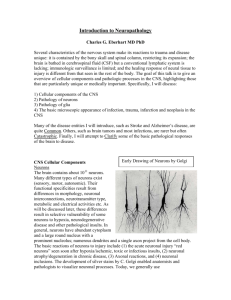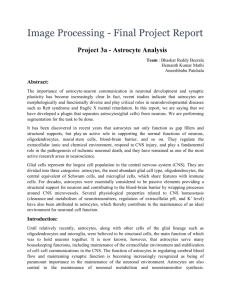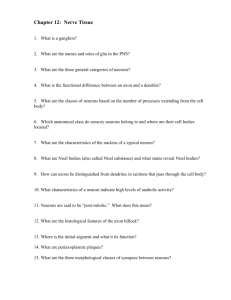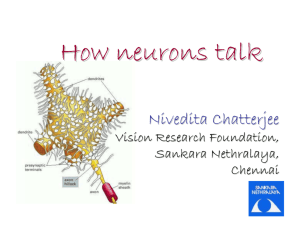Until now the number of glial cells and neurons in a human brain
advertisement
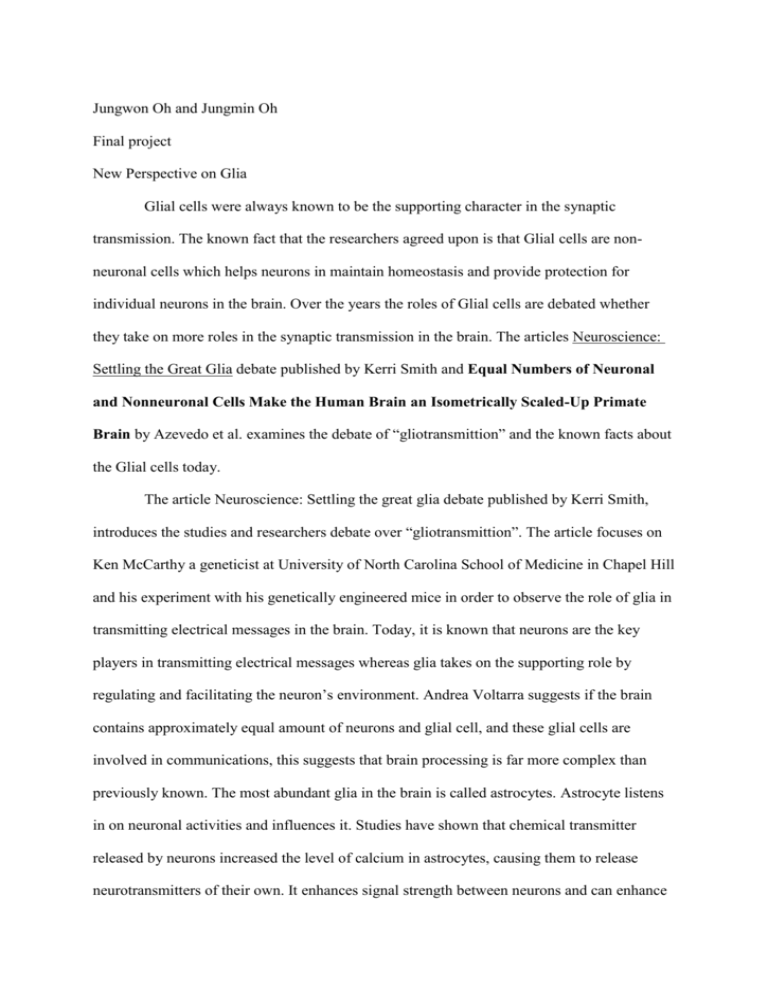
Jungwon Oh and Jungmin Oh Final project New Perspective on Glia Glial cells were always known to be the supporting character in the synaptic transmission. The known fact that the researchers agreed upon is that Glial cells are nonneuronal cells which helps neurons in maintain homeostasis and provide protection for individual neurons in the brain. Over the years the roles of Glial cells are debated whether they take on more roles in the synaptic transmission in the brain. The articles Neuroscience: Settling the Great Glia debate published by Kerri Smith and Equal Numbers of Neuronal and Nonneuronal Cells Make the Human Brain an Isometrically Scaled-Up Primate Brain by Azevedo et al. examines the debate of “gliotransmittion” and the known facts about the Glial cells today. The article Neuroscience: Settling the great glia debate published by Kerri Smith, introduces the studies and researchers debate over “gliotransmittion”. The article focuses on Ken McCarthy a geneticist at University of North Carolina School of Medicine in Chapel Hill and his experiment with his genetically engineered mice in order to observe the role of glia in transmitting electrical messages in the brain. Today, it is known that neurons are the key players in transmitting electrical messages whereas glia takes on the supporting role by regulating and facilitating the neuron’s environment. Andrea Voltarra suggests if the brain contains approximately equal amount of neurons and glial cell, and these glial cells are involved in communications, this suggests that brain processing is far more complex than previously known. The most abundant glia in the brain is called astrocytes. Astrocyte listens in on neuronal activities and influences it. Studies have shown that chemical transmitter released by neurons increased the level of calcium in astrocytes, causing them to release neurotransmitters of their own. It enhances signal strength between neurons and can enhance or mute the signals. Also astrocytes can also communicate with different synapses. Studies show that astrocytes take part of a process called “neuronal threesome”. Figure 1 shows and explains the steps involved in “neuronal threesome”. Ken McCarthy argues that in the previous studies taken place, they were working with flawed methods/procedures. He claims that their method of targeting astrocytes also affects neurons as well. In his lab his target was to solely target the astrocytes alone and eventually will observe the gliotransmission. In his lab, he genetically engineered mice with astrocytes signaling disability. The results show that with that mutation there was no significant effect on neuronal transmission. In studies done by McCarthy, when given one mice a boost in calcium signaling in astrocytes and one without the boost, the results shows no significant effect on neuronal activities suggesting astrocytes aren’t releasing chemical signals to the neurons. However, regardless of all the criticisms towards the existence of gliotransmission, there are many supporting researches done. The study by Dmitri Rusakov at University of College London and Stphane Oliet at University of Bordeux suggest that chemical D-Serine released by astrocytes on the surface of neuron can lead to activation of receptor NMDAR which influences neurons’ behavior. The receptor NMDAR is important in learning and memory, hence making it important in enhancing the synapses. Also Justin Lee at Korea institute of Science and Technology found evidence that astrocytes release GABA and the cells can actually transmit chemicals directly through an ion channel. Other studies have thought it was released through vesicle. Ken McCarthy counters this study by saying that inducing calcium into the cells on a Petri dish is like an “atom bomb”. He believes that when you inject calcium, it will increase the level of calcium at an unnatural rate making it behave strangely by forcing production of transmitters or preventing it from releasing. Many researchers are trying to prove McCarthy wrong. Haydon argues that techniques McCarthy uses are too vague. In order for you to measure the activities of astrocytes, it requires precise methods which McCarthy’s experiments with his animals don’t provide. By taking astrocytes out of developing brain of mice, the brain can confuse the actual function and role of astrocytes. Others arguments over McCarthy’s experiment argues that techniques that are used for measuring neuronal activity might not work on astrocytes because of their differences in synaptic mechanism. Haydon’s team used IP3 phosphate which blocks releasing of calcium in mice. Evidence suggests that these mice have decreased calcium signaling and synaptic transmission in the hippocampus is also affected implying astrocytes help the synaptic transmission to take place. Haydon uses more accurate method than McCarthy’s by observing only certain area of brain and only in certain specific time. This implies that astrocytes functionality can differ in different time and in different part of the brain. There are no “killer evidence” that either McCarthy’s or Haydon’s studies are correct. The debate is continues over the perspective of glial cells. In the article Equal Numbers of Neuronal and Nonneuronal Cells Make the Human Brain an Isometrically Scaled-Up Primate Brain by Azevedo et al., finds helpful information about glia and the number of neurons and non-neuronal cells in the brain. Until now the number of glial cells and neurons in a human brain remains uncertain. There is still an ongoing debate of what the exact proportions for glial cells versus neurons in a brain. As stated in this abstract, it is quoted repeatedly in many statements found in literature and Neuroscience textbooks that mammals with brain sizes that are 5 to 7 times larger than expected for a mammal of its body size have 100 billion Neurons and ten times more in glial cells. But due to experimental studies only being able to be accomplished for only a few parts of the brain, the cellular composition of the brain as a whole, is still yet to be determined. As scientists began studies on the estimated number of cells in the human cerebral cortex, the numbers vary from as little as 3 to as large as 21 - 26 billion and 28 to 39 billion glial cells. Studies in the cerebellum show an estimate of 70 or 101 billion neurons to only 4 billion glial cells. Based on this given information as supported by this abstract, the total number of neurons in the human brain can be estimated to about 75 to 125 billion cells. One thing to make note of is the uncertainty of how many neurons are present in certain parts of the brain such as the brainstem, diencephalon and basal ganglia that may or may not be small (Azevedo et al). Because of this there is no solid evidence proving the common statement that there are ten times more glial cells than neurons located in the human brain. One possible explanation for this hypothesis is if there is a set confirmed amount of glial cells in the remaining undetermined structures; "entire human brain, would be the presence of one trillion glial cells..." On top of this, they studied the cellular scaling rules and the power laws relating body mass, brain, mass, and the number of neurons that apply to the brains of rodents and primates and found that in the brains of primates, the neuronal cell size is not affected by the mass of the brain and the brain of 100 billion neurons should have the weight of 1.45kg belonging to a 73kg body. With these rules applied, "we thus set out to determine the total cellular composition of the human brain with the aid of the same method and relying on the same Criterion of NeuN labeling to identify neurons and nonneuronal cells in order to evaluate how its composition compares with the expected composition of a primate brain of its size." The materials the experiment used were a total of 4 human brains were obtained from the Brain Bank of the Brazilian Aging Brain Study Group with approval from the Ethics committee for Research Projects Analysis and permission to remove brains to be used for experimental studies. These brains were from males of ages 50-, 57-, 54- and 71-, when were deceased not from neurological causes and without any cognitive impairment. The reason for the brain of the 71 year old was due to its slightly greater number of neurons than the other brain. Lastly, these brains were all contained in 4°C until they were removed less than 24 hours of death and fixed immediately by perfusion. Fixating for less than 48 hours is crucial because it allows antibody recognition of the NeuN, while keeping the nuclei intact throughout the homogenization procedure. Then the main parts that were going to be experimented; the cerebellum, cerebral cortex and RoB, were dissected and these three parts were again divided into smaller pieces. The tests on these pieces were done and then were added together. Isotropic fractionators allowed them to determine the total number of cells in each structure and differentiate the NeuN positive from the nonneuronal nuclei. Results on this experiment show that nonneuronal and neuronal ratio in the whole human brain is as close to 1. Figure 2 and 3 shows that there does no relationship between the fractional distribution of neurons in the human brain and the fractional distribution of mass among brain structure. It also shows that in the different part of brain contains different amount of neuronal and nonneuronal cells. Certain parts of the brain contain more neurons whereas others can have more nonneuronal cells. The experiment also found that the ratio of neuronal/nonneuronal to be 0.99. According to the isometric scaling rules and the results found through this experiment, the number of neuronal and nonneuroanl cells found in the human brain falls close to the values expected for a primate brain of human dimensions. With the results of this experiment, with the ratio of nonneuronal to neuronal Cells being l:l, we can easily suggest that the ratio of glia to neurons can be significantly smaller than what is commonly quoted. Although this study has shed some light on the number of glial cells to neurons, there is still an uncertainty on the other specific structures not yet identified. As stated in the discussion portion in this article, "According to the common view in the literature, the glia: neuron ratio increases with brain size, leading to a predominance of glial cells in large brains that would be compatible with a 10:l ratio in humans." This would in fact be applied to the brains of rodents, but as the study on primates which was done here, the neuronal cells are still stable whether or not the neuronal cell size increases. They came to a conclusion that the low glia:neuron ratio is not because of the lacking of glia cells in the cerebellum but it is because of the rather large quantity of tiny neurons. The debate over glia and their role still continues today. There are a lot of researches done to find the evidence of the gliotransmission. Through the researches and studies, there are more and more new perspectives gained on the role of glia. The information gained through both articles suggest that there are still more information about glia that we still need to examine and uncover. Reference Azevedo A.C. Frederico, Carvalho R.B. Ludmila, Grinberg T. Lea, Farfel Marcelo Jose Ferretti E.L. Renata, Leite E.P. Renata, Filho Jacob Wilson, Lent Robert, HerculanoHouzel Suzana.,(2009). Equal Numbers of Neuronal and Nonneuronal Cells Make the Human Brain an Isometrically Scaled-Up Primate Brain. The Journal of Comparative Neurology, 513:532-541. Bear M.F., Connors B.W., & Paradisco M.A.(2007). Neuroscience Exploring the Brain:Third Edition. Baltimore:Lippincott Williams & Wilkins. Smith K, (2010). Neuroscience: Settling the Great Glia Debate. Nature, 468,160-162. Figure 3. Figure 2 Figure 1.

